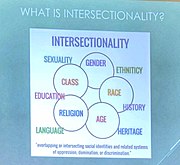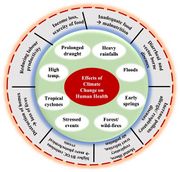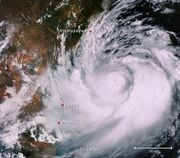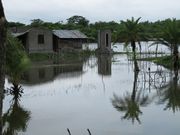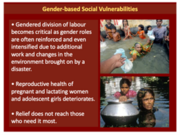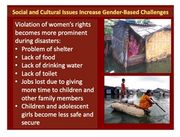BaCCC/Module 5/Lesson 2/Part 1
Contents
Mode 5, Lesson 2: Different Lived Experiences of Climate Change and Responses to It, Part 1
Introduction
The impacts of climate change are experienced differently by vulnerable categories of people than by those who are more privileged and resilient. This lesson will help you explore how the most vulnerable – children, women, poor nations and poor people within nations, Indigenous peoples, people with disabilities or poor health, other marginalised people, outdoor workers and people living in small island states – experience climate change and respond to climate change.
(You can adjust the playback speed and/or turn on subtitles/captions.)
H5P Object Parameters
The H5P parameters below will be replaced by the actual H5P object when it's rendered on the WordPress site to which it's been snapshotted.
The following is said about gender and intersectionality:
| “ | Gender is never just about gender. People are never defined by one characteristic. They don’t experience privilege and justice in just one way. Intersectionality is about complexity. We often hear about women and girls who are most vulnerable to disasters. But we don’t probe further into who these women and girls are, the circumstances that they are under, what is happening or why it is happening. Intersectionality helps us understand the bigger picture and look at issues holistically. | ” |
| —Fordham, cited in The Daily Star, 2022 | ||
| “ | Gender, along with other socioeconomic factors such as class, ethnicity and age, influences people’s vulnerability to climate change and their capacity to adapt. If these differences are not recognized in NAP [National Adaptation Plan] processes, there is a risk that the people with the greatest need for adaptation will be left behind. | ” |
| —Dazé, 2021 | ||
Addressing climate change requires an inclusive approach that considers the unique needs and perspectives of different groups of people, especially those who are most vulnerable and marginalised due to their race, gender, class, ethnicity, age, ability and other intersecting factors.
By centering intersectionality in climate action, we can ensure that the voices and needs of those most impacted by climate change are heard and that solutions are tailored to their specific circumstances. This approach leads to more effective and equitable outcomes in mitigating and adapting to climate change.
Terminology
The following terms are important in understanding the science behind climate change. If you want to remember them, write their meanings in your learning journal as you encounter them in the course content.
- ethnicity
- gender
- indigenous
- intersectionality
- marginalised
- socio-economic
- vulnerable
Different people’s lived experiences of climate change
How do climate change-induced disasters impact vulnerable and marginalised people?
- Poor people can suffer from malnutrition, as they fail to procure enough or the right kinds of food due to the salination of agricultural lands (sea level rise or storm surges), crop loss or damage (heatwaves, drought or pests), loss of livestock or wildlife (heatwaves, drought or flooding), damaged or destroyed fishing grounds (floods carrying run-off) or grazing lands (drought) or higher prices for essential groceries (all of the above).
- Rural women and girls can experience an increase in sexual violence, as they must go further from home to acquire food and water (due to heatwaves, drought or floods).
- Farmworkers and other outdoor manual labourers can lose their jobs if crops are ruined or temperatures are too high to work. Some must leave home to find employment to support their families.
- Elderly people, children and people with disabilities can find it difficult to get outside and lead their normal lives because of damaged or destroyed roads or pathways, schools or parks (floods or mudslides).
- In countries where people of different races and ethnicities live together, it is often people of colour who are impacted first and worst. In predominantly white countries or regions, colonialism and environmental racism have marginalised many communities of colour. This is also the case when comparing impacts on people in the Global South (less developed regions) versus the Global North (more developed regions).
- Those with pre-existing health challenges can be more vulnerable to heat stress (heatwaves), water-borne diseases (floods) or air pollution (dust or toxic fumes caused by extreme weather events or wildfires).
- Socio-economically marginalised groups can have their homes damaged or destroyed (severe windstorms or tornadoes, cyclones, typhoons or hurricanes), or lose their belongings due to looting following an extreme weather event.
- In one research study in a coastal area, it was found that men with disabilities were the most vulnerable group during a disaster. (We must never make assumptions!)
For news stories and photographs of recent cyclone impacts in Bangladesh, see:
- Making Disaster Risk Reduction Gender Sensitive[2]
- Disaster Preparedness Paradigm Shift[3]
- What Happens When a Super Cyclone Hits at the Height of a Pandemic?[4]
- Recovery, Restoring and Building Resilience[5]
Probably best understood now is how the impacts of climate change are felt differently by people of different genders.
The negative impacts of climate change are threatening the food security, livelihoods and existence of 160 million people in Bangladesh, especially poor women, [the] elderly, people with disability, ethnic minority and growing children. Impacts of climate change, such as drought, floods, extreme weather events like cyclones, and food and water insecurity, affect women and men differently while making the poorest more vulnerable. (International Centre for Climate Change and Development, 2023)
A study conducted in the Sundarbans Delta [of Bangladesh] found that, in reality, the impact of disasters is not equally distributed, rather it depends on a variety of social and economic factors. Women and girls suffer more compared to men and boys. (Bhatt, cited in The Daily Star, 2022)
More about gender-based challenges in the context of climate change: Climate change impacts people differently based on their roles and responsibilities, which are often defined by gender. For example, in the agriculture sector in many countries, men are typically responsible for commercial crops whereas women may be responsible for subsistence crops that feed the family.
| “ | Because climate shocks affect each differently, their adaptation needs are different. For example, during a drought, men need to adapt to a loss of income, while women will be managing increased household food insecurity. Further, in many contexts, women and non-binary individuals face barriers in accessing resources and opportunities. This can result in fewer resources being available to them, making it more challenging to manage risks and respond to crises. | ” |
| —Dazé, 2021 | ||
However . . .
- "We shouldn’t neglect the vulnerabilities of men. It is necessary to address the needs of both men and women using an intersectional lens. In an ongoing research study in the coastal area, we found that men with disabilities are the most vulnerable group during a disaster. So men need to be incorporated in our development plans. Intersectionality is an indication of that." (Uddin, cited in The Daily Star, 2022)
- "Flooding and drought “can have disproportionate impacts on low- and fixed-income communities. The most vulnerable residents may live in places that are more exposed to flood waters or in older, less safe housing. Elderly, sick, and disabled residents can be particularly isolated and vulnerable to climate effects. . . . At a larger scale, poorer communities simply have fewer resources to prepare for and cope with impacts. . . . [W]e have a moral obligation to protect the health, safety, and well-being of those most vulnerable and least empowered." (Union of Concerned Scientists, 2016)
In terms of age in the context of climate change, children (like the elderly) are among the most vulnerable to its impacts. As such, their needs and perspectives should be given greater attention in policy and decision-making processes related to adaptation, especially since children rarely have the opportunity to speak up for themselves.
Almost every child on Earth is exposed to at least one climate or environmental hazard. And, according to UNICEF, approximately 1 billion children are at an extremely high risk of the impacts of the climate crisis. Children are a particularly susceptible sub-population when it comes to the impacts of climate change. Their smaller bodies make them more vulnerable to extreme heat, pollution and other environmental hazards, such as high winds or torrential floodwaters. Furthermore, children may be more susceptible to particular diseases and health conditions that can be exacerbated by climate change, such as respiratory illnesses, asthma and malnutrition.
In addition to facing particular vulnerabilities due to their age and size, children may also face intersecting vulnerabilities related to factors such as poverty, gender, disability and ethnicity, among other things. For example, children from marginalised communities may face particular challenges in accessing education, healthcare and social services that could help to build their resilience to climate change impacts. Similarly, children with disabilities may face additional barriers to accessing adaptive technologies and services that can support their well-being and adaptation to changing climate conditions.
Furthermore, children may lack the knowledge, skills and resources necessary to effectively cope with the physical and psychological or emotional impacts of climate change. In addition, their reliance on adults and social support networks means that they are particularly vulnerable to disruptions in social and economic systems that may occur because of climate change.
If there are children in your family or community whom you care about, read:
The Impacts of Climate Change Put Almost Every Child at Risk[6]
Over the past three decades or so, Bangladesh has developed climate risk reduction and mitigation mechanisms to address the adversities that Bangladeshis frequently experience. However, there are inclusion challenges in risk management in the region. In most cases, exclusion (marginalisation) cuts across intersectional groups and contexts.
To conclude, researchers have identified that physical, economic and social vulnerabilities are closely linked, which imposes differential climate change impacts based on age, gender, race or ethnicity, physical disability and other marginalised identities.
References
- ↑ Akhter, S. H. & Fordham, M. n.d. Intersectionality Mime
- ↑ The Daily Star, n.d. Making Disaster Risk Reduction Gender Sensitive
- ↑ The Daily Star, n.d. Disaster Preparedness Paradigm Shift
- ↑ Reachwater, n.d. What Happens When a Super Cyclone Hits at the Height of a Pandemic?
- ↑ The Daily Star, n.d. Recovery, Restoring and Building Resilience
- ↑ UNICEF, n.d. The Impacts of Climate Change Put Almost Every Child at Risk
